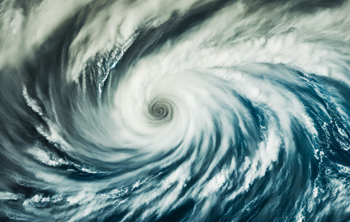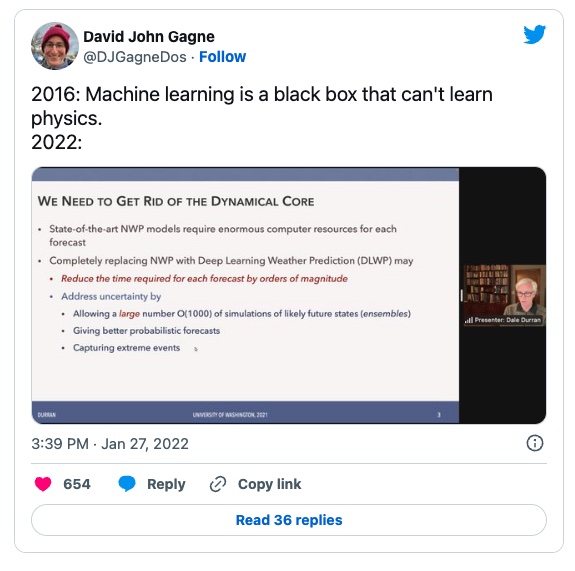
Can artificial intelligence help predict the weather?
If you think putting up with another winter is difficult, you should try modelling one.
The weather we experience is a result of the complex physics within the atmosphere and the oceans, governed by the equations of thermodynamics and fluid dynamics. But some of these equations are incredibly difficult, perhaps even impossible, to solve, so researchers use computers to approximate the solutions of the equations involved, in an approach called numerical weather prediction (NWP). Improving mathematical techniques and increasing computer power has given us more accurate forecasts. But could artificial intelligence be the future of weather modelling?
"The [Earth's weather] is a difficult task to model for conventional tools in principle," said Peter Dueben from the European Centre for Medium-range Weather Forecasts (ECMWF). "It's showing chaotic dynamics and turbulent features, so errors are growing exponentially. It's complex in the sense that you have lots of components interacting with each other, [and the] multiscale interactions between these components aren't clear.... But on the other hand we have a huge amount of data." Dueben says that 100 terabytes of data a day are generated and stored just from the standard forecasts made by ECMWF.
Bring the machines
"We need tools to process this data in a meaningful way, and machine learning is a very good way to do this in principle," says Dueben. Machine learning is a highly successful approach to artificial intelligence. Powerful new computer hardware is now coming online that is customised specifically for the mathematical techniques used by machine learning. And on top of this there is now a lot of good and easy-to-use machine learning software available: "Researchers, with limited knowledge of [the programming languages], can generate good machine learning tools because the software is there."
In machine learning, rather than explicitly writing an algorithm for a computer to approximate the solutions of known mathematical models based on the physics of the weather, the researchers instead write an algorithm that would allow the computer to learn its own model for taking the input weather data and making a forecast. Rather than starting with equations describing the physics involved, the computer starts with a large number of relatively simple equations (called artificial neurons) that are linked together into a neural network. As the machine learning algorithm runs through the vast amounts of existing weather data available, it uses ingenious methods to adjust the strength of the links between the neurons until it produces forecasts that closely match this training data.
Dueben was speaking at a workshop organised as part of the Mathematics for Deep Learning (Maths4DL) research programme. Machine learning has already had significant success in many applications that impact all areas of our lives, including medicine and conservation. "The knowledge is there," says Dueben. "There are something like 100 papers coming out every day. We are more able to customise machine learning to specific situations."
Now or later?
Machine learning has already been very successfully applied to different aspects of weather forecasting. Nowcasting is forecasting over very short time periods, predicting the weather just a few hours into the future. This very short term forecasting is a challenge for conventional weather models as it takes so much computer power and data. For example, the National Oceanic and Atmospheric Administration (NOAA) produce some of the most respected NWP weather forecasts, but they are limited by the resolution of the data the models can take (they can only zoom down to blocks of about 5 kilometres in size) and it can take a number of hours to produce a single forecast.
As Jason Hickey from Google Research explains, this approach is not good for predicting things like localised storms that might evolve within a few hours and require immediate decisions from diverting traffic to planning evacuations. Instead, Hickey and his colleagues from Google Research used machine learning to create a weather forecasting model that does not rely on a previous understanding of atmospheric physics. The team used radar images of rainfall data to train a neural network to forecast how these radar images would evolve over time. Their neural network could then make predictions almost instantaneously and with much less computer power. And what's more, their predictions were far more accurate when tested against real life, as can be seen in the visualisation below. (You can read more in their paper and in Hickey's accessible explanation.)

Left: The 1-hour prediction using NOAA's NWP forecast (1-hour is the limit of this system). Centre: The ground truth, i.e., what the models were trying to predict. Right: The predictions made by the machine learning model built by the Google Research team. (Image: Jason Hickey, Google Research – used with permission)
"You see that the machine learning solution is much more realistic in its representation of the [radar images of rainfall]," Dueben says of the research. Because of the very short time periods, even if a machine learning tool is not perfect, it will still generate a good prediction. And these predictions are often just not possible with conventional tools: "You literally have a couple of minutes to generate the forecast and that is quite difficult for conventional tools."
Machine learning has also been successful in very long-term predictions, says Dueben. The chaotic dynamics of NWP models means any long-term forecasts are very unreliable. Instead researchers need to turn to statistics, rather than a representation of the physical system, to make such predictions. For example the El Niño - Southern Oscillation is an incredibly important weather phenomenon that acts over very long periods of time, impacting the weather across the globe. Researchers have been able to show that machine learning performs well in comparison to the multi-year forecasts of conventional NWP models. (You can see an example of this work here.)
Soon?
These applications are just two of the promising candidates for using machine learning to predict the weather in the very short term, a few hours into the future, and very long term, forecasting over months or years. But what about a few days into the future – the middle time scale of weather forecasting? These medium term forecasts are exactly what Dueben and his colleagues at ECMWF are interested in.
Dueben works in an area called Earth system science. Earth system models currently use numerical weather prediction to model the physics of the atmosphere and ocean. But these two components interact with each other in complicated ways and have an impact on, and respond to, changes in the Earth's surface, particularly changes in ground cover and sea ice. To really understand the weather we need to understand how these different components behave and interact over the whole Earth. So models of the ocean and atmosphere are tightly linked to each other and to mathematical descriptions of other components such as the sea-ice, and the surface of the land, to capture the interactions in a whole Earth system model.

This image of a cyclone has been generated by AI. But will AI soon be able to predict cyclones?
"At ECMWF we won't be replacing our model soon," says Dueben. But they are actively exploring how machine learning can improve the ECMWF's forecasting capability, and they are looking at every aspect of their forecasting process. Work is being done on using machine learning to extract information for the huge data sets, or fuse information from multiple sources together. They are producing benchmark data sets and machine learning algorithms that are available to any scientist to test the performance and capability of new machine learning tools. And they are investigating if they can emulate specific parts of the Earth system models with neural networks that will speed up their forecasts.
"These emulations will hopefully be much faster and more efficient," says Dueben, which is particularly useful for factors that are too costly to model conventionally. For example, a key factor in the weather is how light and heat energy is transferred between different parts of the Earth system. A very simplified model of the effects of clouds on this radiation (called Tripleclouds) is included in the ECMWF forecasts. There is a more advanced model (called SPARTACUS) that includes information on the 3D shape of clouds, but it is four times slower to run. "It's too costly and we can't run it."
Recently ECMWF researchers have had success in emulating the effects of the 3D shapes of clouds by using a neural network to compare the difference between the Tripleclouds and SPARTACUS models. "The prediction of the emulator captures the effects quite well," says Dueben. But the cost of running the emulator is insignificant in comparison to running the SPARTACUS model. "The neural network is basically coming for free. You get the benefit of the 3D effect without having to pay for it." There are still more tests to be done on this particular emulator, but it is one of many promising candidates for replacing standard components in the ECMWF's models. (Read our article Catching clouds with AI to see another promising machine learning approach.)
When?
So is now the time to completely get rid of the equations of physics, and instead call upon deep neural networks (ones with lots of layers, an area of machine learning called deep learning) to do all the work? It is according to Dale Durran, Professor of Atmospheric Sciences and Applied Mathematics at the University of Washington. At the 2022 American Meteorological Society meeting he said "we need to get rid of the dynamical core", completely replacing numerical weather prediction with Deep Learning Weather Prediction (DLWP).

A tweet showing Dale Duran's bold claim for a new approach of Deep Learning Weather Prediction.
"This is quite a bold statement," says Dueben. "The dynamical core is basically the fluid dynamical component of weather models, the core of the model really." But Dale is not just anyone, he literally wrote the book on numerical weather prediction – Numerical Methods for Wave Equations in Geophysical Fluid Dynamics – the book that many researchers used to learn how to build dynamical cores in principle. "He's really a person who knows what he's talking about."
While the ECMWF doesn't expect to replace the dynamical core of their models soon, Dueben is enthusiastic that machine learning is becoming an important tool in weather forecasts."The message is that there are many application areas of machine learning in weather and climate, even if you don't want to replace the entire thing," says Dueben. "Which of these [applications] are useful? We're in the process of finding out. And in the next couple of years we will decide on the most promising and push these into operations."
About this article
Rachel Thomas is Editor of Plus.
Peter Dueben is Head of Earth System Modelling at the European Centre for Medium-range Weather Forecasting.
This article is based on Peter Dueben's talk at the Deep learning in environmental settings workshop that ran in September 2022, organised as part of the Mathematics for Deep Learning (Maths4DL) research programme.